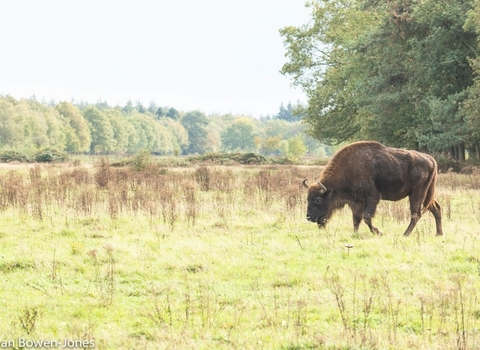Shaping the landscape
Large herbivores, like cattle, ponies and bison, can have a huge impact on the places they live. They're an example of a keystone species. Their actions alter the habitat around them, so they play a big role in determining what other species can thrive. They spread the seeds of plants that get tangled in their fur, create open areas in woodlands where wildflowers can flourish, and entire communities develop in their dung! The UK's ancient landscapes were shaped by herbivores like aurochs and wild horses. These species have been lost, but other large herbivores can help recreate the diverse mosaics of habitat that they once shaped, making more space for the other wildlife that thrived alongside them.
Exmoor ponies
Wild horses can do wonderful things for wild places. They pull up grasses, giving wildflowers room to grow. They chew bark, removing trees and clearing space for other wildlife. By rolling on the ground, or galloping, they create areas of bare earth where pioneer plants can establish and insects can burrow. Their dung is home to fungi, beetles, flies and other invertebrates. Sadly, the true European wild horses are now extinct, but many domesticated breeds share the same traits and can live a wild lifestyle. This includes the Exmoor pony.
Many Wildlife Trusts use Exmoor ponies to graze their nature reserves, including:
- Avon Wildlife Trust welcomed Exmoor ponies to Folly Farm to help reduce the bramble cover on some of the reserve's steep grassland areas, allowing more wildflowers to flourish.
- Cornwall Wildlife Trust uses a variety of ponies to graze their nature reserves, including Penhale Dunes - one of the county's largest dune systems. Exmoor ponies live on the reserve year-round, helping to maintain the important dune plant communities.
- Durham Wildlife Trust graze their nature reserves with Exmoor ponies to maintain wildflower meadows.
- Hampshire & Isle of Wight Wildlife Trust has introduced two Exmoor ponies to their rewilding project at Wilder Little Duxmore. The ponies will help shape the landscape as this former arable farm returns to nature.
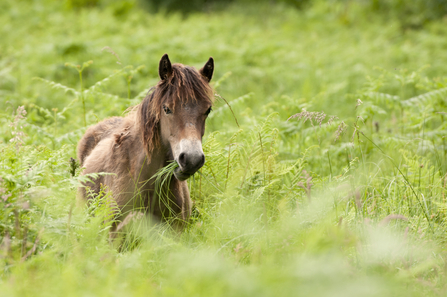
Exmoor pony © Ross Hoddinott/2020VISION
Highland cows
Cattle are the domesticated descendents of the ancient aurochs. They break trees, creating space in woodlands where flowers can grow and birds can nest. They keep areas open by grazing on young growth, and transport plant seeds in their hair, on their hooves and in their dung. Birds often follow them around to feed on the insects they attract or disturb with their steps, whilst cow pats are prized by many beetles and flies. Cattle, in the right places and in the right numbers, can be an important part of shaping and maintaining healthy wild landscapes.
Many Wildlife Trusts welcome Highland cows to their nature reserves to help with conservation grazing, employing their landscape-altering abilities to maintain a healthy variety of habitats. Examples include:
- The Wildlife Trust for Beds, Cambs & Northants uses Highland cattle to graze their nature reserves, clearing scrub and course vegetation so that wildflowers can thrive. You can help by sponsoring a highland cow!
- Derbyshire Wildlife Trust is using Highland cows to help transform Allestree Park into the UK's largest urban rewilding space.
- Gloucestershire Wildlife Trust has introduced Highland cattle to areas of the Forest of Dean to open up space for wildlife, such as the small pearl-bordered fritillary.
- North Wales Wildlife Trust uses Highland cows to graze Cors Bodgynydd Nature Reserve, benefitting plants and wildlife. This includes marsh clubmoss, which only occurs at a few locations in Wales.
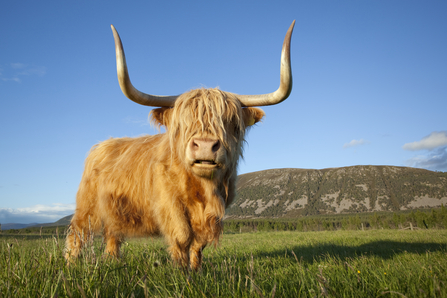
Peter Cairns/2020VISION
Water buffalo
Water buffalo are more at home in damp habitats than the cattle used for conservation grazing, so can be very handy for helping shape the vegetation on wetlands. They will graze the water-logged areas that cattle tend to avoid. Several Wildlife Trusts have introduced water buffalo to their nature reserves to graze wetter areas, including Herts & Middlesex Wildlife Trust. They have employed water buffalo to graze Thorley Wash Nature Reseve, a rare example of fen habitat. By grazing ditches and removing coarse and scrubby plants, the buffalo will clear space for the reserve's water voles to thrive. Without the buffalo, Herts & Middlesex Wildlife Trust would need to use heavy machinery to keep the ditches clear.
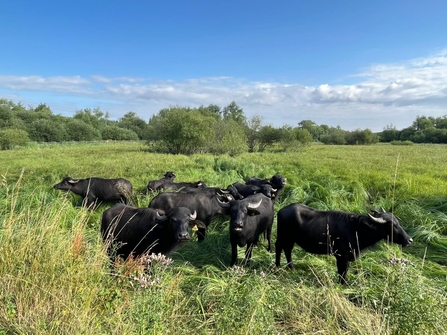
Water buffalo © Robert Phillips
Bison
Bison shape the landscape in many of the same ways as cattle, but as larger animals they can have even more of an impact. They strip bark and fell trees, not only letting light reach the woodland floor but also creating deadwood, an important feature for many woodland species. Bison also love to sand bathe. They roll around on the ground, creating sandy hollows where pioneer plants can grow, insects can burrow and reptiles can bask. Conservation work in Europe has brought bison back from the brink and they now play a vital role in many rewilding and wilding projects across the continent.
In July 2022, Kent Wildlife Trust and Wildwood Trust introduced three European bison into an area of West Blean and Thornden Woods, as part of their Wilder Blean project. In September 2022, a bison calf was born, and in December a bull arrived from Germany, taking the herd to five. They are monitoring the way bison transform the woodland, to see the effect on other wildlife and the overall diversity of the site. This is the first time this approach has been trialled in the UK.
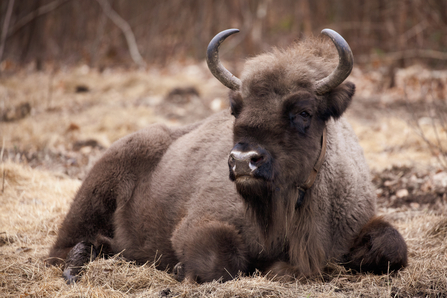
Bison © Donovan Wright
The Wildlife Trusts and the Large Herbivore Working Group (LHWG)
The restoration of a large herbivore guild is integral for nature recovery. The Royal Society of Wildlife Trusts is pleased to host the Large Herbivore Working Group (LHWG). Membership of the LHWG is made up of experts in the fields of ecology, conservation, academia, law and policy, and its aim is to advance the return of large grazing and browsing animals to aid in the restoration of natural processes to the UK. To this end, the LHWG works to provide guidance, influence policy and enable shared learning which would be supportive of this agenda and by extension support a wilder Britain. Membership spans across the UK and Europe, and includes organisations such as The Wildlife Trusts, the Knepp Estate, the Lifescape Project, the Zoological Society of London (ZSL), The National Trust, and Rewilding Britain.
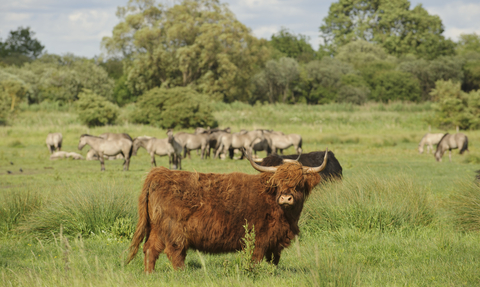
© Terry Whittaker/2020VISION

